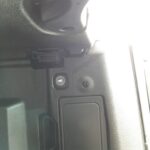It’s a common question for owners of older vehicles: does a 1998 GMC Jimmy have OBD2? The answer is yes, the 1998 GMC Jimmy, like most vehicles manufactured in the United States in 1996 and later, is equipped with OBD2 (On-Board Diagnostics II). This standardized system is crucial for diagnosing vehicle problems, as it allows mechanics and even DIYers to read diagnostic trouble codes (DTCs) from the vehicle’s computer.
However, just because your 1998 GMC Jimmy has OBD2 doesn’t mean accessing this diagnostic information is always straightforward. You might encounter a “no communication” issue when trying to connect a scan tool. This can be frustrating and prevent you from understanding what’s wrong with your vehicle.
If you’re facing a no communication problem with your 1998 GMC Jimmy, especially alongside symptoms like the engine starting and stalling, a constant security light, and airbag light illumination, there are systematic troubleshooting steps you can take. These steps often involve checking the vehicle’s data communication network, often referred to as the Class 2 data circuit in older GM vehicles.
One critical point to investigate is the splice pack SP205. This splice pack is typically located above the left side footwell light, tucked under the instrument panel (IP) on the driver’s side, near the fuse block. It’s often taped to the wiring harness, so you might need to carefully locate it.
To diagnose a potential communication failure related to SP205, you can follow these procedures:
-
Access SP205 and the DLC (Diagnostic Link Connector): Locate the splice pack SP205 and the DLC, which is where you plug in your scan tool.
-
Isolate the Circuit: Remove the “Comb” from SP205. Connect your scan tool to the DLC. Use a jumper wire to bridge pin D (Purple wire) and pin B (Dk Green wire) on the DLC. Attempt to communicate with the Powertrain Control Module (PCM) using your scan tool.
-
Identify the Faulty Circuit: If communication is established after this step, it indicates a problem within one of the circuits connected to SP205. Use another jumper wire to short pins B and D on the DLC to each of the other pins in SP205, one at a time. Observe your scan tool’s communication status after each short.
-
Pinpoint the Problem Module/Wire: When shorting a specific wire/module causes the scan tool to lose communication (“No Communications”), you’ve identified the problematic circuit.
-
Investigate the Faulty Module’s Circuit: Once you’ve isolated the circuit causing the communication failure, investigate the module connected to that circuit for issues. This could be a circuit failure in the Class 2 data circuit, a power supply problem, or a ground issue affecting that particular module.
Troubleshooting “no communication” issues on a 1998 GMC Jimmy can sometimes be complex. As noted, fixes can vary widely. Common culprits reported include:
- Wiring Damage: Check for wiring damage, especially around the under-hood fuse block and along the negative battery cable, where chafing or breaks can occur.
- Aftermarket Accessories: Incorrectly installed aftermarket accessories, particularly radio wiring, can interfere with the data communication network.
- Water Intrusion: Examine PCM connectors for signs of water intrusion or corrosion.
- Ground Issues: Check for loose or corroded battery grounds and other critical ground connections.
- Module Malfunctions: In some cases, a faulty module like the Body Control Module (BCM) can cause communication problems.
Diagnosing these issues requires a systematic approach. By methodically checking the splice pack SP205 and isolating circuits as described, you can significantly narrow down the source of the “no communication” problem on your 1998 GMC Jimmy and get your diagnostic efforts back on track. Remember to consult a repair manual specific to your 1998 GMC Jimmy for detailed wiring diagrams and component locations to aid in your troubleshooting process.
